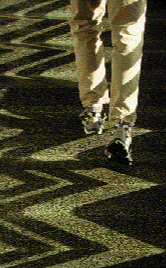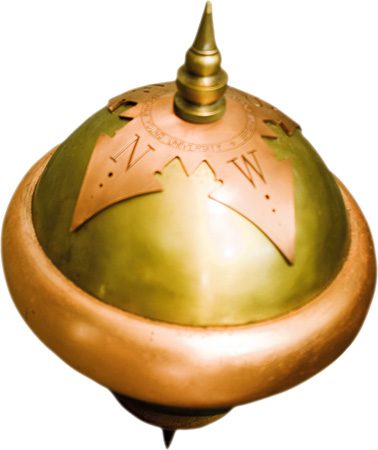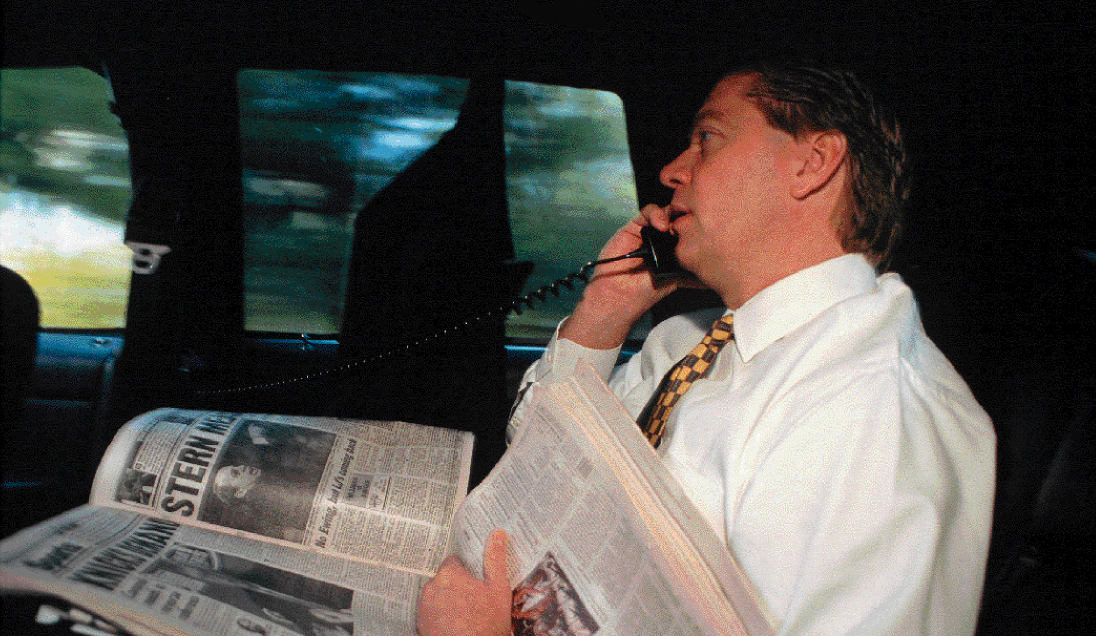By Jeff McClellan
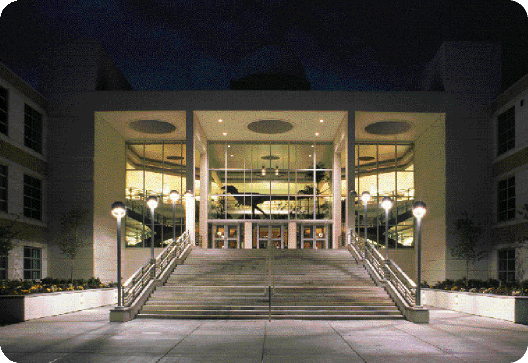
Visitor appeal is much of what gives BYU’s science haven its character. The building is the incarnation of every curious 10-year-old’s fondest dreams. It is an adventure waiting to happen…
It’s 7:35 on a drizzly Friday evening, and friendly chatter fills the Sarah Berret Summerhays Planetarium in BYU’s Eyring Science Center. Some 18 people–students, astronomy buffs, and interested observers–relax into new reclining seats, and voices reverberate off the curved ceiling to allow easy eavesdropping from distant portions of the room. The familiar silhouette of Utah Valley’s rugged horizon runs around the rim of the ceiling. Soon the door closes, the lights dim, and the stars and constellations of the April sky appear. For the next hour spectators are treated to the first planetarium show at BYU in more than two and a half years.
In September 1995 the planetarium was closed and chain-link fences rose around the Eyring Science Center (ESC) as faculty, staff, and students were evicted for an extensive renovation project (see “Giving an Old Building New Tricks,” page 30). Renovation crews gutted the entire structure. “You could stand in one corner of the building and see clear to the other corner,” says Irvin Bassett, a Physics and Astronomy Department staff member who served as building liaison during the renovation. When the fences came down, and scattered members of the homeless departments received the green light to move in over Christmas break 1997, building residents were greeted by a modern facility dressed in a familiar package. “The flavor is still the same Eyring Science Center,” says geology associate research professor David Tingey.

From a certain point in the ESC lobby, visitors can either stare into the gaping jaws of a blue and yellow Allosaurus or admire portrait of the building’s namesake, Carl F. Eyring.
For many faculty and staff, the ESC reopening allowed them to return to a home they’ve enjoyed for upwards of 40 years. “I’ve lived in the building since 1960,” says Bassett, who has filled a number of roles, including that of student. “I remember not too many years ago walking up the stairs and seeing how the steps had been dished out because of all the footfalls on them. And I thought, ‘Boy, those have seen a lot of feet.’ Then I realized, ‘Wait a minute! A good share of those have beenmy feet!'”
In the nearly five decades since the building’s dedication, feet of students, professors, and Cub Scouts have helped the building retain its status as one of the most-used facilities on BYU campus. It also remains one of the largest BYU structures and is arguably the one with the most interesting stories to tell.
Hidden Treasures of Research
Dedicated in October 1950 as the Physical Science Building, the building was renamed the Carl F. Eyring Physical Science Center in 1954. Eyring was a respected and accomplished acoustical physicist who served as dean of BYU’s College of Arts and Sciences for nearly 30 years despite enticing opportunities to leave. The driving force behind the construction of the science center, Eyring died of leukemia just a few months after it opened.

A few clouds don’t deter postdoctoral faculty member Eric Hintz from displaying BYU’s newly donated, $175,000, 16-inch, custom telescope. The Orson Pratt Observatory – like the rest of the building – received a good cleaning and a new paint job during renovation.
Over the years the building has been used for many purposes, but in between art displays and history classes, Church services and social events, the ESC has been primarily occupied with its original charge: scientific research and education. “There’s been a lot of good research take place in here,” says J. Ward Moody, an associate professor of physics.”In the heyday of research, they did some very good things down in the underground lab.”
The underground lab itself is one of BYU’s best-kept and most-intriguing secrets. Tucked under the lawn just north of the ESC, the Underground Physics Research Laboratory contains a fascinating array of equipment: two particle accelerators, a large cubic press, and more than a dozen lasers that researchers are using to push the frontiers of short pulses and wavelengths. The lab was added to the science center in 1968 and has been home to many research projects, from cold fusion to the effects of significant pressure on various materials.
Another of the ESC’s hidden treasures is the acoustics lab. Constructed to be accessed from and surrounded by the science building while remaining structurally independent, the lab provides isolation from outside vibration and sound. Many BYU scientists have used the lab to study the qualities of sound.
In addition to providing facilities in which to do research, the Eyring Science Center has served as a display case for research results. “I used to like the displays of dinosaurs,” recalls H. Mark Nelson, a student when the building opened in 1950 and a physics professor since 1959. Dinosaur Jim, as James A. Jensen is often called, came to BYU as an assistant to the Geology Department and later founded and directed the Earth Science Museum. During his more than 25 years at BYU, he amassed an impressive collection of dinosaur bones, now stored beneath Cougar Stadium. “He would mount those dinosaurs so it looked like they were in combat or chasing each other–oh, it was just wonderful!” says Nelson. For years, Dinosaur Jim’s creations adorned the ESC lobby, delighting visitors of all ages.
Visitor appeal is much of what gives BYU’s science haven its character. The building is the incarnation of every curious 10-year-old’s fondest dreams. It is an adventure waiting to happen–from the observatory to the rock displays to the Foucault pendulum to the dinosaurs. And the labyrinth of hallways has made the building a favorite venue for hide-and-seek and squirt-gun warfare, Bassett says.
“When the planetarium is going, this place is Cub Scout heaven,” says Moody, who was a BYU student and ESC dweller in the late 1970s. “Around every corner there’s something interesting. Even if you’re just waiting for someone, you can learn something.”
The learning in the ESC is more than reading plaques and looking at charts; it’s hands-on, thanks largely to Freeman Andersen, whose official title is “Physics Department Laboratory Supervisor.” His unofficial title? “Toy maker,” he says with a smile.
Andersen’s creations over the past 10 or so years have included the Vortex Cannon, the Magnetic Sand Box, the Big Ears, and the Sewer Pipe Synthesizer, each demonstrating some principle of physics. His most complex toy is the Wave-a-Tron, a circular contraption hanging in the ESC lobby that took two years to develop. Through a computer control center, visitors can make waves of various amplitudes and frequencies and can test how multiple waves interact. Although Andersen builds the toys largely for entertainment value, he says they are often used in classes.
“Physics is fun, and most people don’t know that,” Andersen says. “They think of it as math and equations. Physics is the real beauty of nature to me.”
Legendary Humor
Toying with the “beauty of nature” has spawned a fair amount of humor and mischief in the ESC. Andersen tells of a demonstration gone awry in one of the pit rooms when a professor attached a makeshift bowling-ball pendulum to the ceiling and started it swinging across the room. On its last swing, the ball hit one wall and came back at a weird angle. “It wiped every tap right off the lecture table–scrunched them all off,” Andersen laughs. “We had water shooting in the air, and we had to evacuate the room because the gas was going.”
Then there was the time the Foucault pendulum ball was stolen and missing for weeks before an anonymous tip suggested they dredge the botany pond south of campus. The pendulum has been the target of other schemes, and some claim the pendulum bowl was once filled with water and fish.
Perhaps the most infamous prank played in the Eyring Science Center involved a cat and a carillon. As a gift from four senior classes in the mid-1950s, a carillon was mounted on the roof of the ESC. The instrument played through four huge speakers, loud enough to be heard at Utah Lake on a clear day, claims Rex Arnett, then a student carillonneur.
According to legend, someone put a cat to sleep with chloroform and placed the animal inside the locked rolltop carillon keyboard. When the cat woke up, it began walking around and playing loud, obnoxious noises in the middle of the night.
But Arnett remembers it differently. As the one who discovered the cats (there were two), he insists it was a Sunday afternoon and the cats only made a brief disturbance. The big ruckus, he says, actually happened a few weeks later in March 1956.
About 11:30 one Friday evening, the carillon started going berserk, remembers Arnett. As lights came on all over Provo, Arnett and a police officer struggled through several sets of doors with soldered locks. By the time they reached the carillon, the noise had been going on for more than 30 minutes. “The console was open,” Arnett explains, “and there was a little Erector Set motor that had been attached to the lower part of the keyboard. It had two little arms that came around on the motor and hit two particular keys–bong bong, bong bong, bong bong.”
The incident made quite a stir at BYU and in Provo, but the pranksters were never caught, says Arnett, who graduated with a Spanish degree in 1961.
Impressions of Science
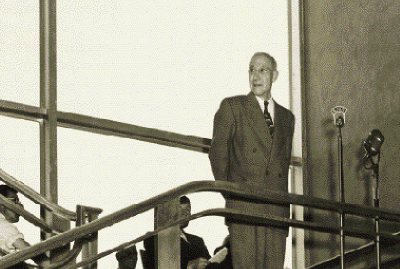
At the building’s dedication in 1950, BYU arts and science dean Carl Eyring – though suffering from leukemia – charged students to “learn that to be a good scientist, the person must also be a good person.”
The ESC carillon is gone now. It was sent to BYU-Hawaii more than 20 years ago when the Centennial Carillon Bell Tower was constructed. The speakers, however, remained to broadcast the national anthem twice daily until 1995, when a helicopter moved them to the Harold B. Lee Library.
A few other features have disappeared as well. The pit rooms, long the ESC’s hallmark, have been replaced by large theater rooms, complete with state-of-the-art multimedia equipment. And in place of the giant ground sloth skeleton stands a fleshed-out model of an Allosaurus, which, according to a current campus joke, got its blue and yellow coloring from eating too many Cub Scouts.
But many things remain. The Foucault pendulum highlights the lobby, the toys are slowly returning, two domes adorn the roof, and school children can visit the planetarium, the observatory, the acoustic chamber, the rock collections, and the underground lab. A few new stops have been added to the tour as well: the Sensory Evaluation Laboratory, designed for scientific taste-testing; dozens of labs filled with high-tech equipment; and the Geology Department’s compact storage systems with space for more than 7,000 rock samples. Of course, the green floors and staircases remain, complete with the indentations made by feet of students long-since graduated.
“It’s still the ESC,” Bassett says. But the building’s value isn’t in the physical structure, he emphasizes. “There’s been a lot of people who have had experiences here. They’ve been in and out. They’ve fought to find their way around and finally found out how to get from one room to another. I think the treasure of the building is in the thousands of people who have had experiences here. It becomes a warm spot in the heart and memory of a lot of people.”
For Physics and Astronomy Department chair Dorian Hatch, the building’s personality emanates from its purpose. “Here is where science and religion meet,” he says. “An expression of those two in a combined, synergistic way, I think, is part of the ESC character.”
Some things at BYU never change. In October 1950 an ailing Carl Eyring stood on the landing of the lobby’s south staircase and addressed the dedication throng: “We must learn that to be a good scientist, the person must also be a good person, an integrated person with faith in God and a performance in righteousness beyond reproach. . . . I expect you young scientists to search for God’s truth in the laboratory.”
Nearly half a century later, young scientists of a new generation are learning to be good people in the building that Eyring built. Many of them, some of whom have been at BYU for two years already, are experiencing the ESC and all its wonders for the first time.
In the lobby one April morning, soft light from a cloudy sky filtered in and around the Allosaurus. The Wave-a-Tron on the ceiling repeated its dual wave pattern once again as scattered students scribbled notes and studied books. The atmosphere was hushed and thoughtful. A professor-type stood at the Foucault pendulum and quietly told a few students how the pendulum works. The group swelled to 10 as interested passers-by stopped to learn. When the professor explained that the pendulum always swings in the same plane while the earth rotates beneath it, the face of one student brightened suddenly and she let out a cry of excitement. Once more the Eyring Science Center was witness to discovery, to understanding, to enlightenment . . . the same enlightenment that has come to thousands of Cub Scouts, fresh-men, graduate students, professors, and alumni–all of them students whose quickly passing feet have brought subtle, lasting change to the green staircases.







